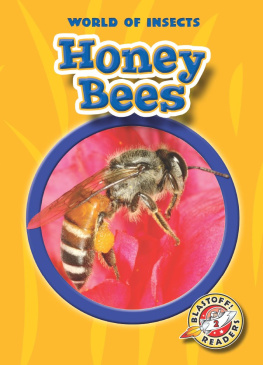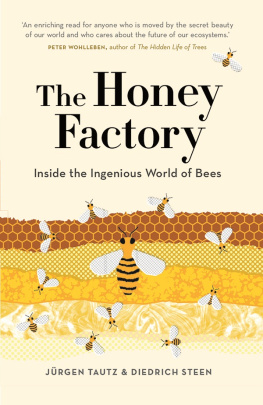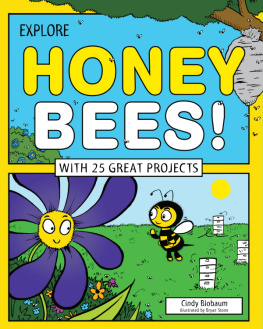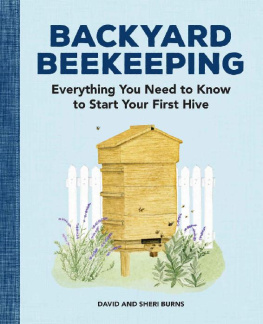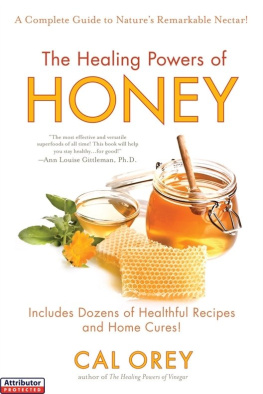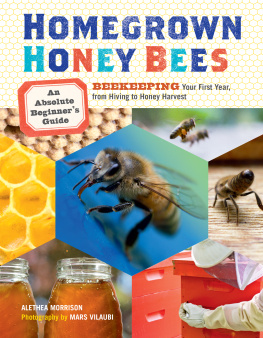
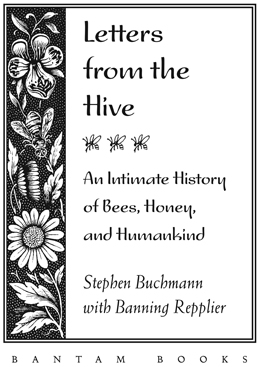
Table of Contents

For my daughters, Marlyse and Melissa,
remembering shared bee adventures in our Tucson backyard
and across the Sonoran desert, with love and gratitude
for making my life complete

Melissa means bee in Greek.
In Greek mythology, Melissa was a bee nymph,
the daughter of King Melisseus, who cared for the young Zeus.
A Linguistic Note:
Honey Bee Versus Honeybee

Throughout this book, we have used the term honey bee rather than the dictionary-approved honeybee. The late insect morphologist Robert E. Snodgrass, in his classic 1956 work on the anatomy of the honey bee, made a very cogent argument for the use of the two-word name over the compound form:
Regardless of dictionaries, we have in entomology a rule for insect common names that can be followed. It says: If the insect is what the name implies, write the two words separately; otherwise run them together. Thus we have such names as house fly, blow fly, and robber fly contrasted with dragonfly, caddicefly, and butterfly, because the latter are not flies, just as an aphislion is not a lion and a silverfish is not a fish. The honey bee is an insect and is preeminently a bee; honeybee is equivalent to Johnsmith.

Introduction

The more we know of other forms of life, the more we enjoy and respect ourselves.... Humanity is exalted not because we are so far above other living creatures, but because knowing them well elevates the very concept of life.
Edward O. Wilson,
Biophilia: The Human Bond
with Other Species
O ften, in quiet moments, I like to contemplate the path that brought me to where I am today. The curious little boy who kept pet fence lizards, raised caterpillars, chased butterflies, chipped fossils out of rocks, and read every nature guide available has metamorphosed into a man with the same deep connection to natureand a profession that is a direct outgrowth of those early interests. But with the passage of years my childhood passion has matured; I now have a sense of the fragility of the natural world I love so much, and I have dedicated my life to doing whatever I can to help preserve it.
As an entomologist specializing in plant pollination by bees, my research has taken me to Australia, Belize, Brazil, Costa Rica, England, Germany, Israel, Malaysia, Mexico, Panama, South Africa, Thailand, and nearly every state in the union. Everywhere Ive been, the story is the samethe once vast wilderness, from spectacular desert landscapes to lush, steaming rainforests, has been chopped up and reduced to isolated islands. Unfortunately, we think only about ourselves, and having inscribed our tale upon the earth, we have little concern for the flora and fauna that share our very finite planet.
About a dozen years ago, I began to think long and hard about the academic research articles I was writing. Was anyone out there listening to what I was saying, did they care, was my work relevant? Was it enough simply to produce well-honed scientific papers and publish them in prestigious journals read only by my colleagues? I had a terrible suspicion that in fact it was not nearly enough and that I should be doing a great deal more to alert the world to the catastrophe it was facing.
It was at that time, with so much of the beauty and diversity of my beloved planet disappearingunder the plow, the parking lot, the subdivision, and the mallthat I began to change my focus. I became a conservationist, one with an evangelical fervor to spread the word and help stop, or at least slow down, the destruction.
Much of the research I now do is directed at helping to investigate and solve the problem of our disappearing pollinatorsthe bees and other insects that, by spreading pollen from one plant to another, enable them to reproduce. As youll see in Chapter 5, the world would be a desolate place without our pollinating friends, devoid of flowers, flowering plants, and many of our favorite foods, including honeythe one Ill be celebrating later in this book.
Being an amateur beekeeper (as well as a professional naturalist, researcher, and conservationist) is deeply important to me. Ive kept honey bee colonies intermittently since my very first one back in 1970. To me, beekeeping is about staying in touch with the pulse of the planet, with its rainforests, deserts, wetlands, and meadows. Living with bees and investigating their ways gives me vital insights into the cycles of nature that enable the ecological world to function. Bees fly out and gather information about the flora in their part of the world, then bring that data back to me. I, in turn, gather information for my work by studying the honey that results from those floral visitations. Thanks to bee watching and honey analysis, I am acutely attuned to my environmentand to the dangers that threaten it.
Making my living from bees and flowers is about much more than getting a paycheck. The more than twenty thousand different kinds of bees found worldwide are my touchstone, allowing me to escape the stressful human environment of concrete, steel, and glass. After hours spent in the confines of a windowless office dominated by a glaring computer screen, my aching head and sore neck muscles tell me its time for a walk in the desert to see what the bees are up to. Nature has the power to teach, to renew, and to heal, something we must never forget.
Stung by the Biophilia Bee
When I was growing up in Orange County in Southern California, my family lived close to Tonner Canyon and the sights, sounds, and smells of the chaparral. Southern California in the late 1950s and early 1960s was much less crowded and polluted than it is today. There were still plenty of wild areas where the dramas of natural history could unfold before my eyespraying mantids grabbing a quick meal, crab spiders prowling in flowers for hidden treasure, caterpillars spinning their cocoons, scurrying salamanders and newts, shy tadpoles and froglets. By the time I was eight years old, I had started to collect insects, filling countless jars in my bedroom museum with the latest bug du jour. I owe a debt of gratitude to my late mother for allowing me to keep this Lilliputian livestock indoors. She didnt always encourage my insect studies, but she didnt forbid them either. During high school, my fascination with bees and flowers blossomed. It all began with a rather misguided (and painfully inept) attempt to plunder a bee nest for honey. Despite well-stung ankles that were so swollen they looked like footballs, and itching that went on long after the pain had subsided, my interest in bees continued, and it only intensified when I went away to college. Im sure my parents wondered when, if ever, I was going to grow out of my bug phase. Im thankful I never did. Im still the ever-curious kid, the insatiable backyard naturalist who has been lucky enough never to grow up. Instead, Ive followed my childhood dreams with childlike abandon all the way into adulthood.
Next page

